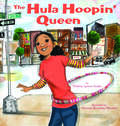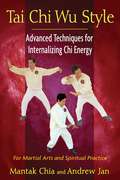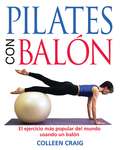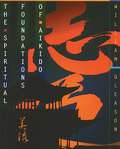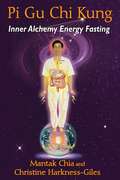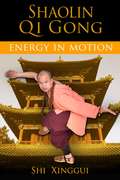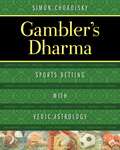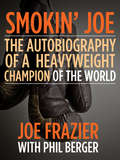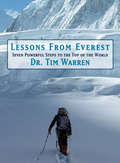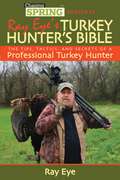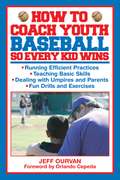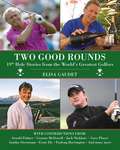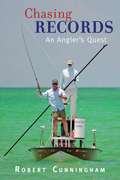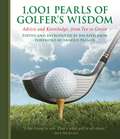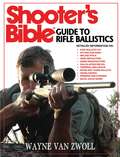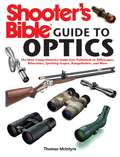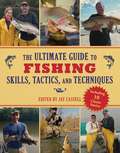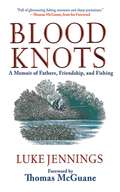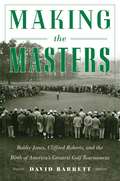- Table View
- List View
Horse Safety
by Elizabeth Moyer Jean AbernathyHorse Safety is a guide to equine safety that gives reliable advice on understanding equine instincts and moods, approaching a horse properly, leading, and working safely around horses. The book gives an overall picture of good horsemanship and emphasizes safe tying (including where to tie, how to use cross ties, and how to tie a quick-release knot) as well as keeping a safe barn and preparing for emergencies. The book also covers pasture safety and riding safety (in the arena and on the trail), including how to find the proper fit for equipment and tack such as helmets and saddles.
The Hula-Hoopin' Queen
by Thelma Lynne GodinA spunky African American girl has a hula-hooping competition with her friends in Harlem, and soon everyone in the neighborhood--young and old alike--joins in on the fun.Kameeka is confident that today she will finally beat her rival, Jamara, and become the Hula-Hoopin' Queen of 139th Street. But then Mama reminds her that today is their neighbor Miz Adeline's birthday, and Kameeka has a ton of chores to do to get ready for the party they are hosting. Kameeka's disappointed to be stuck at home and can only think about the hoopin' competition. Distracted, Kameeka accidentally ruins Miz Adeline's birthday cake, and has to confess to her that there won't be a cake for her special day. But then Miz Adeline's confesses something too: she's also got the itch-the hula-hoopin' itch! Her fingers start snappin'. Her hips start swingin'. Soon everyone's hips are swinging as the party spills out onto the street. The whole neighborhood's got the itch-the hula-hoopin' itch! A spunky African American girl has a hula-hooping competition with her friends in Harlem, and soon everyone in the neighborhood-young and old alike-joins in on the fun. With vibrant illustrations by Vanessa Brantley-Newton, The Hula-Hoopin' Queen is a charming celebration of family and community ties. Set in Harlem, this intergenerational story shows the importance of staying young at heart.
A Morning with Grandpa
by Sylvia LiuIn this sweet, slice-of-life story, a curious and active Asian American girl spends the day learning tai chi from her grandfather, and in turn tries to teach him how to do yoga.Mei Mei's grandpa is practicing tai chi in the garden, and Mei Mei is eager to join in. As Gong Gong tries to teach her the slow, graceful movements, Mei Mei enthusiastically does them with her own flair. Then Mei Mei takes a turn, trying to teach Gong Gong the yoga positions she learned in school. Will Gong Gong be able to master the stretchy, bendy poses? Winner of Lee & Low's New Voices Award, A Morning with Grandpa celebrates, with lively spirit and humor, the special bond between grandparent and grandchild and the joy of learning new things together. Readers of all ages will want to try some tai chi and yoga too!
Tai Chi Wu Style: Advanced Techniques for Internalizing Chi Energy
by Mantak Chia Andrew JanA guide to the internal martial arts exercises of short-form Wu-Style Tai Chi • Details the 8 core forms of Wu-Style Tai Chi with fully illustrated instructions • Ideal for older practitioners as well as those with health disabilities due to the “small frame” primary stance, slower and smaller movements, and conservation of energy • Explains how Wu Style provides a natural introduction to martial arts boxing • Reveals how Wu Style eases stiffness, relieves back pain, and reduces abdominal fat Following the flow of chi energy, rather than directing it as in traditional Tai Chi, Wu-Style Tai Chi focuses on internal development, seeking to conserve chi energy and gather jin power from the Earth through the tan tien. Centered on a “small frame” stance--that is, feet closer together and arms closer to the body--and a slower progression of movements in solo practice, Wu Style offers a gentle Tai Chi form for beginners and, when practiced with a partner, a grounding introduction to martial arts boxing and Fa Jin (the discharge of energy for self-defense). The more functional stance, smaller movements, and conservation of internal energy make Wu-Style Tai Chi ideal for older practitioners as well as those with health disabilities. Condensing the 37 movements of Wu Style into 8 core forms, Master Mantak Chia and Andrew Jan illustrate how to build a personal short-form Wu-Style Tai Chi practice. They explain how Wu-Style Tai Chi removes energetic blockages and helps to elongate the tendons, reducing stiffness and allowing the limbs to return to their natural length and full range of motion. Regular practice of Wu Style relieves back pain as well as reducing abdominal fat, the biggest hindrance to longevity. Exploring the martial arts applications of Wu Style, the authors trace its history beginning with founder Wu Chuan-Yu (1834-1902) as well as explain how to apply Wu Style to “Push Hands” (Tui Shou) and Fa Jin. Through mastering the short-form Wu Style detailed in this book, Tai Chi practitioners harness a broad range of health benefits as well as build a solid foundation for learning the complete long-form Wu Style.
Pilates con balón: El ejercicio más popular del mundo usando un balón
by Colleen CraigAn exciting synthesis of two highly acclaimed fitness techniques: Pilates Method and the Swiss exercise ball • Exercises for all ability levels • Shows how to practice Pilates techniques without expensive equipment • Profusely illustrated with black-and-white photographs for maximal learning The Pilates Method of body conditioning aligns the body, builds long, lean muscles, and develops core abdominal strength. Many lifestyle and fitness magazines have named Pilates the hottest workout of the decade. Pilates on the Ball merges the principles and exercises of the Pilates Method with the unique functions of the exercise ball. The ball intensifies athletic performance by increasing resistance and heightening awareness of how the body moves in space. Chapters detail the Pilates principles step by step, with movements intense enough to engage seasoned athletes, yet accessible enough to use as an everyday exercise routine.
Strength Training on the Ball: A Pilates Approach to Optimal Strength and Balance
by Colleen CraigA unique series of Pilates strength-building exercises using the Swiss exercise ball, resistance bands, and weights• From the bestselling author of Pilates on the Ball and Abs on the Ball• Features specialized strength-training workouts for readers of all ages and fitness levels• Chapters include check points to help readers set realistic goals and tips for physical educators, coaches, and Pilates teachersIn Strength Training on the Ball Colleen Craig shows readers of all fitness levels how to build strong bones, improve balance, and reduce body fat while toning and defining the body. Combining the unique functions of the exercise ball with the endurance- and flexibility-building benefits of strength training, Craig presents 75 ball exercises using weights, resistance bands, and the body's own resistance. Her exercise variations make strength training safe for beginners, children, teenagers, and seniors and challenging enough for the seasoned athlete.Strength Training on the Ball is modeled after Craig's groundbreaking and bestselling works Pilates on the Ball and Abs on the Ball. It contains step-by-step photographs for each of the exercises, check points to help readers set realistic yet motivating goals, and teaching tips for physical educators, coaches, and Pilates teachers. The book concludes with three specialized strength workouts: a therapeutic workout for those recovering from injuries, a basic workout for absolute beginners, and a challenging workout for athletes and gym enthusiasts.
The Spiritual Foundations of Aikido
by William GleasonMorihei Ueshiba, who founded Aikido early in this century, intended that his martial art would give form to profound spiritual truth, and lead to a unification of the world's peoples. He saw Aikido not as a fighting method or as a competitive sport but rather as a means of becoming one with the laws of universal order--ki, or life energy. Unfortunately, the subtleties of Ueshiba's teachings, veiled in the esoteric terminology of Shinto, can be puzzling for even the most advanced practitioners. They are not passed down today, and have never been introduced to the West. Gleason, a fifth-degree (Godan) black belt in Aikido, recognizing the importance of the spiritual aspects of the discipline, researched its roots in Shinto, and in this book is able to offer a clear explanation of Ueshiba's teachings.• Unlike the common "how-to" manuals on basic technique, this is the first book to introduce the underlying spiritual principles of Aikido--the elusive concept of kototama (word souls), expressed as one spirit, four souls, three origins, and eight powers--and how they relate to the forms.• Teaches the student how to use Aikido to accomplish spiritual goals. • Reveals little-known teachings of Shinto and Aikido, relating them to Buddhism, Christianity, and other spiritual teachings.
Pi Gu Chi Kung: Inner Alchemy Energy Fasting
by Mantak Chia Christine Harkness-GilesA step-by-step guide to the Taoist fasting practice of Pi Gu • Explains how you do not stop eating with this fasting practice and details the simple pi gu diet • Illustrates the chewing and chi kung practices to accompany pi gu, for natural chi energy production • Reveals how Pi Gu Chi Kung activates the body’s natural healing abilities, accelerates the elimination of toxins, reduces appetite and cravings, and enables you to draw energies from the Earth and Universe Pi gu is an ancient Taoist method of fasting for spiritual and healing purposes. Unlike traditional fasting, you do not need to stop eating when practicing pi gu. Used by ancient Taoist masters during their months or years of solitary retreat in pursuit of enlightenment, the practice centers on a simple diet of fruits, teas, nuts, and eggs paired with special chewing techniques and chi kung exercises. During the pi gu state, the need for food decreases yet the body’s energy levels actually increase. The body gathers chi not from food but from chi kung and the “golden elixir” produced by the pi gu chewing practices. The chi produced through pi gu charges your internal organs, activating the body’s natural healing abilities and enabling you to draw energies from the Earth and Universe. In the pi gu state the body automatically balances itself, the mind is more relaxed, and sleep improves. The pause in normal eating makes the body’s cells more sensitive, accelerating the elimination of toxins. The stomach reduces in size, flattening the belly, eliminating cravings, decreasing appetite, and naturally producing weight loss. The body’s meridians stay open, making it easier to attune to meditation, chi kung, and energies from the cosmos. Providing a step-by-step guide to Pi Gu Chi Kung, Master Mantak Chia and coauthor Christine Harkness-Giles explain the pi gu diet, provide immortality tea recipes, detail the pi gu chewing exercises, and illustrate the corresponding chi kung energy exercises. They also explain the use of pi gu during darkness retreats to enhance spiritual awareness and increase mental powers and wisdom.
Treat Concussion, TBI, and PTSD with Vitamins and Antioxidants
by Kedar N. PrasadThe most up-to-date resource on nutritional supplements for the prevention and improved management of concussive injury, TBI, and PTSD • Provides an easy-to-follow program of supplements to optimize the benefits of treatment programs and offer a method of prevention beyond the use of helmets • Shows how standard treatments do not address the oxidative stress, chronic inflammation, and high glutamate levels that promote brain injury progression • Explains how single micronutrients do not provide the same preventive benefits as the synergistic combinations explored in the book The human brain is highly complex. When brain injury strikes, whether from a blow to the head or the shock of physical or emotional trauma, successful treatment requires a multilevel approach, taking into account the health of the brain prior to injury. Multilevel, complementary treatment approaches can also be applied to strengthen the uninjured brain and help prevent neurological injury for those at high risk of concussion, post-traumatic stress disorder, and traumatic brain injury. In this practical scientific guide, leading researcher in cancer, heart disease, and Alzheimer’s prevention Kedar N. Prasad, Ph.D., reveals the latest revolutionary discoveries on the use of antioxidants and micronutrients to manage and prevent concussive injury, TBI, and PTSD. He explains that increased oxidative stress, chronic inflammation, and glutamate release are common underlying factors in these conditions and should be addressed for improved management. He debunks the flawed conclusions of the neurological community that vitamins and antioxidants are ineffective for these conditions, revealing how their studies focused on specific micronutrients rather than synergistic combinations. The author details his easy-to-follow supplement program to treat and prevent these injuries, outlining the correct daily amounts and proper combinations of vitamins, antioxidants, micronutrients, and polyphenolic compounds such as curcumin and resveratrol. Offering the missing complement to standard medical care of brain injury as well as a form of prevention beyond the use of helmets, this guide provides a truly holistic approach to the prevention and management of concussive injury, TBI, and PTSD.
Shaolin Qi Gong: Energy in Motion
by Shi XingguiAuthentic qi gong as practiced in the Shaolin Temple where this discipline originated centuries ago • Reveals the fundamental spiritual principles and includes both a short and long form of the daily exercises• Explains the benefits of mastering energy in the body, such as organ strengtheningThe great teacher Bodhidharma is credited with the creation of Shaolin Temple qi gong and kung fu in the 6th century CE. Motivated by the terrible physical condition of the monks who spent all their time meditating or copying scrolls, his two-part system promoted physical as well as spiritual fitness and became the basis for all the martial and meditative arts taught in the Shaolin Temple. These ancient practices increase physical health and vitality, enhance creativity, and can be practiced well into old age.Author Shi Xinggui, a Shaolin monk, explains the fundamental principle of qi gong--the art of mastering energy (qi) and moving it through the body--and provides clear demonstrations of all the positions and movements. In order to develop qi attentively, it is necessary to cultivate the art of slowness in both movement and breathwork. Shi Xinggui provides both a short form and a long form of the daily exercises, with lessons on heart centering, organ strengthening, and balancing the energy using the three dantians--the three energy centers of the body.
Gambler's Dharma: Sports Betting with Vedic Astrology
by Simon ChokoiskyWin bets on sporting events using the prediction system of Vedic Astrology• Describes the basics of Vedic Astrology and how it can be applied to sports betting• Outlines 5 powerful techniques for predicting the outcome of any one-on-one competition• Details how to determine the physical strength of each side, whose motivation and drive to win is strongest, and who has fate on their sideEverything that is born, which has a lifespan and an ending, is a space-time event. That includes contests as well as human beings. And just as your personal astrological chart can describe success or failure in various areas of your life, so too can a contest chart created from the time, date, and location of an event show us winners and losers of one-on-one competitions.Drawing on traditional Vedic Astrology as well as his own research and winning experience, Simon Chokoisky outlines 5 powerful techniques for predicting the outcome of any competition between two opponents with 70–80 percent accuracy. He explains how sports betting offers black-and-white outcomes and you do not have to be an advanced astrologer to understand the principles in this book or to apply them to daily life. Using examples from his bets in the World Cup and baseball, the author shows how to judge the favorite and determine the underdog’s chances by looking into the body, mind, and soul of a team and its players. He details how to use the planets to determine the physical strength of each side and whose motivation, mental toughness, and drive to win is strongest as well as the more subtle spiritual nature of each team--who is luckier and who has fate on their side. He details how he used these simple principles to win hundreds of bets and how he now uses them to fund charitable causes.Including personal stories of his experiences with grace, beginner’s luck, and the Vedic philosophy of karma and dharma, Chokoisky demonstrates how the planets and stars relate not only to our sports competitions but also our individual lives. He shows us how the astrologer must become part of the prediction, how a bad day can mean bad luck, and how to ride the wave of good fortune by avoiding specific days that are ill-disposed to betting. Chokoisky explains that one way to remain in the good graces of the gods is to donate a portion of your winnings to charity. He describes how right conduct is essential to continue profiting from this technique and how your own karma and dharma can indicate how to approach gambling as well as how to use your winnings.
Smokin’ Joe: The Autobiography of a Heavyweight Champion of the World, Smokin’ Joe Frazier
by Phil Berger Joe FrazierWhen boxing was bold, bright, and glamorous and the fights were the hottest sporting events of the year, Joe Frazier was king as the Heavyweight Champion of the World. From 1970 to 1973 he reigned. With a career record of 32-4-1 with twenty-seven knockouts and an Olympic gold medal, Frazier leaves little question that he was one of the greatest fighters of all time. Well-known, loved, and revered as a gentleman and a fierce competitor in the ring, Joe Frazier speaks his mind in Smokin' Joe--about growing up poor and fighting in the first $2.5 million bout; about the early days of his friendship with Muhammad Ali and how their relationship changed; and about the often corrupt world of boxing and what really went on inside and outside the ring. Personable, good-natured, and funny, Frazier's story is a real delight.
Lessons from Everest: Seven Powerful Steps to the Top of the World
by Dr Tim Warren"Into Thin Air" meets "The Secret" with a splash of humor! After a devastating failed attempt to climb Mt. Everest in 2007 and a brief period of mourning, Dr. Tim Warren became focused on learning the lessons that had been revealed to him while hiking alone for three days down the Khumbu Valley of Nepal to heal his damaged lung tissue in the luxury of oxygen-rich lower altitude. He felt an overpowering desire to return to the mountain the next year and experienced a clear vision of himself at the summit and arriving safely back in base camp. After testing those lessons over the next year-and-a-half, and within an inch of his life, he achieved this goal. Equally importantly, he realized that the lessons learned on the "Big E" were universal to people seeking to overcome difficulties in life or simply to edge a little closer to their full potential. Lessons From Everest describes seven lessons, each a stepping stone to greater understanding and awareness of the reader's inner journey to their own Everest with a healthy dose of seat-of-your-pants adventure.
Who's Who of Pro Basketball: A Guide to the Games Greatest Players (Who's Who of Pro Sports)
by Tyler OmothIntroduces readers to the most dynamic pro basketball stars of today and yesterday, including notable statistics and records.
Ray Eye's Turkey Hunting Bible: The Tips, Tactics, and Secrets of a Professional Turkey Hunter
by Ray EyeLegendary turkey hunter Ray Eye provides all of the information you need to know to successfully hunt wild turkeys across the country: how to scout, how and when to call, special tactics for the early season, how to hunt pressured turkeys, how to hunt heavy timber or open fields, and much, much more. Told in Ray's down-home, folksy manner, the book not only informs, but entertains as well. There's also a bonus storytelling section that will have you laughing in stitches as you read of some of Ray's more ponderous exploits.
Golf Miscellany: Everything You Always Wanted to Know About Golf (Books of Miscellany)
by Matthew SilvermanWhat causes a golf ball to hook or slice? What are the origins of the terms "bogey" and "birdie"? Why was Jack Nicklaus called "The Golden Bear"? "Why is the Masters champion presented with a green jacket? How many tournaments did Byron Nelson win in 1945?With Golf Miscellany, the fascinating history and lore of golf are finally revealed! For example, the reason a golf ball hooks or slices is that its spin drags a layer of air across one surface of the ball faster than it does across the opposite surface. "Bogey" refers to a score of one over par on a golf hole, the term originating from a British song from the late nineteenth century. Jack Nicklaus was dubbed The Golden Bear by his former agent, Mark McCormick, because he was "large, strong, and blonde." Every Masters champion since 1949 has been presented with a green jacket, indicating their membership in the exclusive private club. And the great Byron Nelson won a whopping eighteen tournaments in 1945 including eleven in a row, both records which stand to this day.Packed with all manner of delightful surprises, beautiful illustrations and photos, and surprising nuggets of information, Golf Miscellany demystifies the origins and customs of one of the world's most celebrated game. From the driving range through the U.S. Open, you'll be entertained with fun, little-known facts. Why do golfers wear collared shirts? Who invented the modern putter? What golfer was famous for saying he dug his golf game out of the dirt? Settle into your favorite armchair, sip on an Arnold Palmer, and find out!
How to Coach Youth Baseball So Every Kid Wins
by Orlando Cepeda Jeffrey OurvanCoaching youth baseball is tough. Not only do coaches have to teach kids the fundamental skills of the game, they also have to know how to select a team, how to run efficient practices, and how to deal with parents and umpires. Furthermore, they have to make sure the game is fun for all the kids on their team. Jeff Ourvan is an experienced youth baseball coach who has determined that what makes the experience of little league so special is the values it teaches. In How to Coach Youth Baseball So Every Kid Wins, he outlines a plan of action for youth coaches to follow that will enable them to field a team that plays together, plays well, and has lots of fun in the process.
Two Good Rounds: 19th Hole Stories from the World's Greatest Golfers
by Elisa GaudetEverybody loves a celebration, and golfers are no exception. It has long been a tradition after a round of golf to gather together and celebrate a win or merely enjoy the company of friends, new and old, with a second round at "the 19th hole," a slang term used in golf that refers to a pub, bar, or restaurant on or near the golf course. Two Good Rounds is an interna-tional tribute to great golfers and the golf lifestyle, which often includes the enjoyment of drinks. In each chapter, golf writer Elisa Gaudet asks a notable professional golfer the same questions:What is your favorite drink?What is your favorite clubhouse or 19th hole?And what is a special time or memory from a 19th hole?The results yielded a wide array of answers ranging from crazy celebrations after a win to heartfelt memories of childhoods spent playing golf with family and friends. From the Arnold Palmer (½ lemonade, ½ iced tea) to the margarita (the preferred drink of tour star Vijay Singh), drinks and golf are inextricably linked. Two Good Rounds shows you how.
Chasing Records: An Angler's Quest
by Robert CunninghamFor most anglers, catching a world-record fish is something they can only fantasize about. "Maybe," the angler thinks, "I'll get lucky." But if the reason you fish is to catch world-record fish, then luck is only a very small part of it, as Robert Cunningham has learned in the course of a long quest during which he has caught fifty-seven world-record fish, as certified by the International Game Fish Association (IGFA). Cunningham's pursuit of record fish began on the remote and austere Chandeleur Islands off the Louisiana coast, which he reached flying his own seaplane, and where he chased and landed several world-record redfish. Cunningham then moved offshore, where he took record cobia and dolphin on both conventional tackle with a fly rod, and set an astonishing eleven world records in one year. Cunningham has caught record fish in the sloughs of the Mobile River Delta, the interior lakes of the Bahamas, and along tide rips more than one hundred miles offshore in the Gulf of Mexico. He has fought potential world-record fish for eight hours, only to lose them at boatside, and then gone back for more, and along the way, learned all manner of angling skills as well as the ability to shake off the (literal) bad breaks. His account of one angler's obsession is full of humor, disappointment, and triumph.
1,001 Pearls of Golfers' Wisdom: Advice and Knowledge, from Tee to Green (1001 Pearls)
by Arnold Palmer Jim ApfelbaumThere's an old adage about sports writing that says "the smaller the ball, the better the writing." The quotes that make up 1,001 Pearls of Golfer's Wisdom prove that to be most definitely true! Including great golfers from all around the world and every era of history--Ben Hogan, Bob Hope, George Bernard Shaw, Gary Player, John Updike, Laura Baugh, Tom Watson, Lee Trevino, Donald Trump, Winston Churchill, Bill Murray, and more--these quotes offer wit and wisdom on every stroke and situation. With a foreword from the great Arnold Palmer, this is certainly a book that makes a great gift for golfers everywhere, even if they have to buy it for themselves.
Shooter's Bible Guide to Rifle Ballistics
by Wayne Van ZwollPublished annually for more than eighty years, and with over seven million copies sold worldwide, Shooter's Bible is the most complete and sought-after reference guide for new products, specifications, and current prices on thousands of firearms and related equipment. The 103rd edition contains up-to-date handgun and rifle ballistic tables along with extensive charts of currently available bullets and projectiles for handloading, as well as a new products section. Complete with color and black and white photographs showcasing various makes and models of firearms and equipment, Shooter's Bible is the perfect addition to the bookshelf of any beginner or experienced hunter, firearm collector, or gun enthusiast.
Shooter's Bible Guide to Optics: The Most Comprehensive Guide Ever Published on Riflescopes, Binoculars, Spotting Scopes, Rangefinders, and More
by Thomas McintyreWhether you are a target shooter, hunter, guide, tactical user, birder, or sports spectator, optics play a vital role in enhancing and facilitating your sport or profession. To help you figure out which optics best fit your needs, as well as your budget, the Shooter's Bible Guide to Optics lists every quality sporting optic on the market today. Loaded with color photographs, this 256-page book features a new products section, listing all new riflescopes, binoculars, rangefinders, and spotting scopes, plus in-depth features on how to use binoculars, how to mount and sight in a rifle scope, and much more.
The Ultimate Guide to Fishing Skills, Tactics, and Techniques: A Comprehensive Guide to Catching Bass, Trout, Salmon, Walleyes, Panfish, Saltwater Gamefish, and Much More (Ultimate Guides)
by Jay CassellWith fishing advice from such experts as Bill Dance, Roland Martin, Wade Bourne, Tom Rosenbauer, Kirk Deeter, Charlie Meyer, Conway Bowman, and Lamar Underwood, The Ultimate Guide to Fishing Skills, Tactics, and Techniques profiles all of the major gamefish in both fresh and salt water and reveals pro secrets on how to catch them. Learn how Roland Martin entices largemouths with striking lures. Study Bill Dance’s twenty tricks for consistently catching bass in thick weed beds or clear, open water. Want to know what Kirk Deeter and Charlie Meyer have learned from their years of fly fishing for trout? How about Lamar Underwood’s tools for success? It’s all here, divided into sections on bass, trout, walleyes, pike-pickerel-muskellunge, panfish, salmon, steelhead, catfish, ice fishing, and salt water fishing for easy reference. You’ll also find sections on knot tying, boats and boating, comfort and safety on the water, and even delicious recipes for cooking your fresh caught fish.This volume also includes a classic reading section featuring stories from such fishing literary legends as Nick Lyons, Ted Leeson, John Taintor who remind us what fishing is really all about.
Blood Knots: A Memoir of Fathers, Friendship, and Fishing
by Thomas Mcguane Luke JenningsBlood Knots is a brilliant and dramatic memoir of an angler's life. It places Jennings in the front rank of natural history writers. As a child in the 1960s, he was fascinated by the rivers and lakes around his home. Beneath their surfaces waited alien and mysterious worlds. With library books as his guide, he applied himself to the task of learning to fish. His progress was slow, and for years, he caught nothing. But then a series of teachers presented themselves, including an inspirational young intelligence officer, from whom he learned stealth, deception, and the art of dry-fly fishing. So began an enlightening but often dark-shadowed journey of discovery. It would lead to bright streams and wild country, but would end with his mentor's capture, torture, and execution by the IRA. Blood Knots is about angling, about great fish caught and lost, but it is also about friendship, honor, and coming of age. As an adult, Jennings has sought out lost and secretive waterways, probing waters at dead of night in search of giant pike. The quest, as always, is for more than the living quarry. For only by searching far beneath the surface, he suggests in this most moving and thought-provoking of memoirs, can you connect with your own deep history. Jennings offers here a striking, elegiac narrative for lovers of unique memoirs and the finest fly-fishing literature.
Making the Masters: Bobby Jones and the Birth of America's Greatest Golf Tournament
by David BarrettContested the second weekend in April each year since 1934, the Masters is the world's most prestigious golf tournament and most-watched tournament on television. Tickets are in such demand that even the waiting list is closed, and players value the title above all others. In Making the Masters, award-winning golf writer David Barrett focuses his attention on how the Masters was conceived, how it got off the ground in 1934, and how it fully established itself in 1935. The key figure in the tournament's creation and success was Bobby Jones, who was a living legend after winning the Grand Slam in 1930 and immediately retiring at the age of twenty-eight. He went on to found Augusta National and sought a high-profile tournament for his new course. But nearly as important was Clifford Roberts, a banker friend of Jones who not only embraced Jones's vision but became his right-hand man in working to bring that vision to reality. Barrett explores how Jones and Roberts built the Masters from scratch, creating a golf institution embellished by the often surprising details of what that entailed as they were trying to establish a golf club and golf tournament in tough economic times. It also vividly chronicles the events of the 1934 and 1935 Masters, with Gene Sarazen's spectacular victory in 1935 providing the climax. Set against the backdrop of golf, and America, in the 1930s, the book provides an informative and entertaining read for fans of the Masters and students of golf history.

